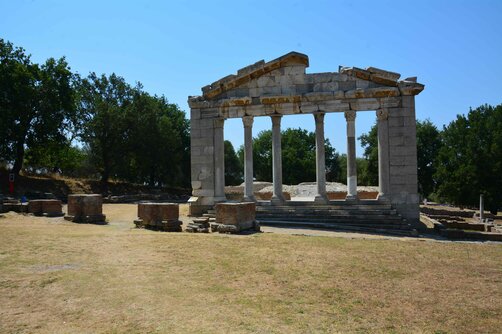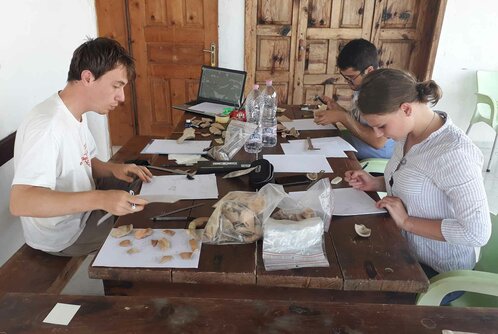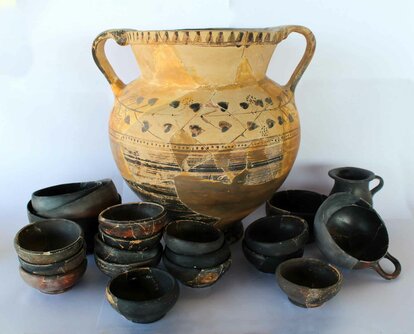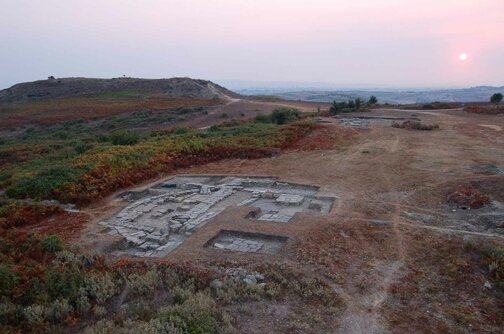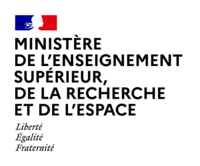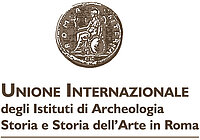APOLLONIA. Apollonia Illyria (Albania). Survey, excavation and Franco-Albanian archaeological studies
- Section: Antiquity
- Directors: Stéphane Verger, Director of studies at the École Pratique des Hautes Études, Director of UMR 8546 AOROC
- Network of French schools abroad: in collaboration with the École française d’Athènes
Presentation
The Franco-Albanian mission of Apollonia Illyria studies the history and topography of the Greek city from its foundation, around 600 BC, to the beginning of the Byzantine period, through a programme of geophysical survey, stratigraphic excavations and studies of archaeological material.
In 2018, the French-Albanian epigraphic and archaeological mission of Apollonia of Illyria celebrates its first quarter century. Founded in 1992 by Pierre Cabanes and Neritan Ceka, it is based on a scientific partnership that has just been renewed for four years through an agreement signed between the Archaeological Institute of Tirana, UMR 8546-AOrOc (CNRS-ENS-EPHE, PSL University) and the Écoles française de Rome and Athènes, in collaboration with the Institute for Research in Ancient Architecture (USR 3155). The work is being carried out in coordination with the Archaeological Park of Apollonia.
Partners
Programme of the French Schools Abroad (Écoles françaises à l'étranger/EFE): École française d'Athènes and École française de Rome
In partnership with:
- Archaeological Institute of Tirana
- Ministry of Europe and Foreign Affaires
Expected results
The 2018-2021 quadrennial programme aims to see the completion of several volumes of publications on the excavation results since 1994; and the resumption of field work in two areas: the northeastern gate and the intermediate zone between the Hellenistic agora and the monumental Roman centre.
Three volumes in preparation:
- The first one, relating to survey and stratigraphic test trenches in the upper city (2004-2008), is nearing completion, due to additional studies and photogrammetric survey of the architectural remains (roofs and lapidary decorations, F. Quantin).
- The second volume looks at the area of House G and in particular the large sewer that borders the Roman house. The study of the stratified ceramics (M.- H. Barrière) and metallic material (S. Veseli) has been completed. The latest photogrammetric surveys carried out this year will allow the development of the topographical and architectural chapter (J.-L. Lamboley, A. Skenderaj).
- The third volume deals with a series of homogeneous stratigraphic contexts from the archaic and classical period uncovered in the upper city during excavations in 2010-2014 (S. Verger, S. Shpuza). These are two backfills containing a rich ceramic series from the sixth century BC and the filling of a well covering the fifth and first half of the fourth century. Lastly, it informs us about the Hellenistic assemblages from the stratigraphic layers that date the great portico and the monuments which border the north and west sides of the agora of the upper town (C. Rocheron).
Development of the storage facilities:
In addition, the campaign involves preparatory work essential for the resumption of field research. This begins with a renovation plan for the excavation house, which was built in 1996 with funding from the French Ministry of Foreign Affairs and the Albanian Government. This year, we are completing the fitting out of the reserves with storage shelves for the archaeological material.
Plans:
In the field, it was necessary to replace the local coordinate system which was in use until now for topographic surveys and architectural surveys – instead, a system of international coordinates that will georeference the remains throughout the urban area will be introduced (Ph. Lenhardt and S. Shpuza). This new network will notably be used for the completion of the 3D photogrammetric model of the ancient city, started in 2017 and completed this year in the peripheral zones and up to the tumulii of the necropolis.
At the same time, the photogrammetric survey programme for the monuments of the upper town, starting with the curtain walls of the fortification surrounding the north-east gate, will continue, with a view to resuming excavations in this area. This work represents a project for the architectural and archaeological study of the fortification, which will be carried out in the coming years (N. Genis).
Layout of the site tour:
Finally, the team is helping with the renewal of the visitors’ site tour by redoing the trilingual explanatory panels, in partnership with the Archaeological Park and the French Embassy in Albania.
Training:
The site also has a role in practical training for archaeologists. This year, three archeology students from the University of Tirana took part in the work and learned how to deal with ceramics (from washing to recording and drawing), sorting and cleaning painted plaster and stucco, and recording the ancient wall facing in the ACoR database. Several guided visits of the site and the museum were organized.
The team
Project directors
- Stéphane Verger, Director of studies at the École pratique des hautes études, Director of UMR 8546-AOrOc (CNRS-ENS-EPHE, University PSL, Paris)
- Belisa Muka, Director of the Department of Antiquties and the Archaeological Institute of Tirana
Statutory members of the team
- Jean-Luc Lamboley, professor at the University of Lyon 2, senior member of the Institut universitaire de France, UMR 5189-HiSoMA
- François Quantin, professor at the University of Aix-Marseille, Director of USR 3155-IRAA
- Shpresa Gjongecaj, professor at the Archaeological Institute of Tirana, numismatist and former director of the institute
- Saïmir Shpuza, researcher at the Archaeological Institute of Tirana
- Altin Skenderaj, researcher at the Archaeological Institute of Tirana
- Philippe Lenhardt, architect at USR 3155-IRAA
- Nicolas Genis, scientific member of the École française d’Athènes, UMR 5189-HiSoMA
- Lavdosh Jaupaj, doctoral researcher at the Archaeological Institute of Tirana
Participants 2018
- Jean-Baptiste Houal, research engingeer at the CNRS, UMR 8546-AOrOc
- Marie-Hélène Barrière, postdoc, UMR 5189-HiSoMA
- Fabien Bièvre-Perrin, postdoc, USR 3155-IRAA
- Cécile Rocheron, postdoc, UMR 8546-AOrOc
- Jordan Boucard, doctoral student, University of Paris I, UMR 7041-ARSCAN
- Émelyne Dabit-Boudon, doctoral student at the University of Aix-Marseille, USR 3155-IRAA
- Cédric Jaouën, MA in architecture and archaeology, ENSA Strasbourg
- Linda Papi, doctoral student at the École Pratique des Hautes Etudes, UMR 8546-AOrOc
- Martin Jaillet, student at the École normale supérieure
- Mathilde Ferrari, topography and 3D modelisation at the Institut National de Recherches Archéologiques Préventives (INRAP)
- Christophe Bailly, assistant engineer at the CNRS, UMR 8546-AOrOc
- Zef Qitaj, student at the University of Tirana
- Daniela Ferko, student at the University of Tirana
- Elisabeta Mosho, student at the University of Tirana

